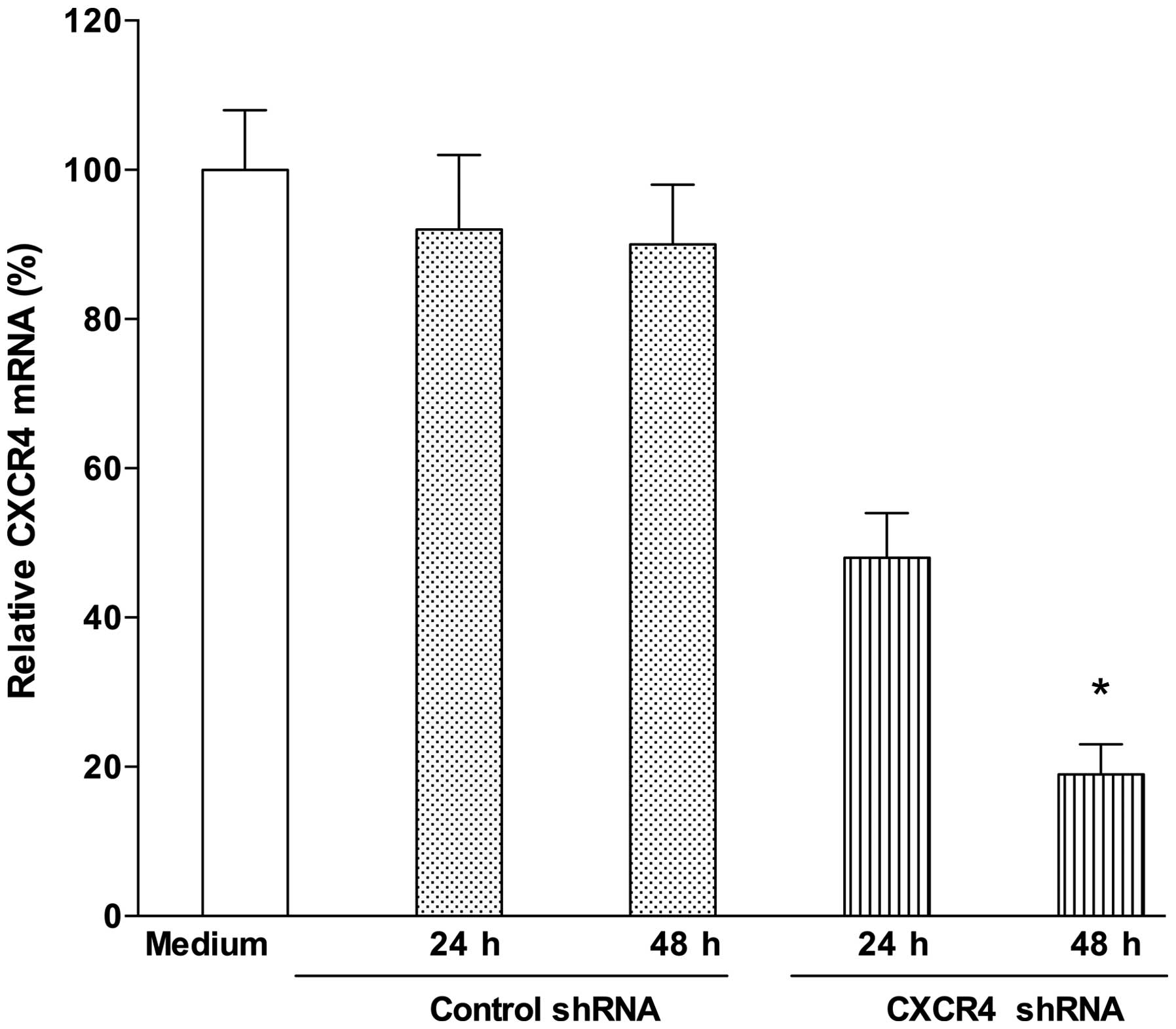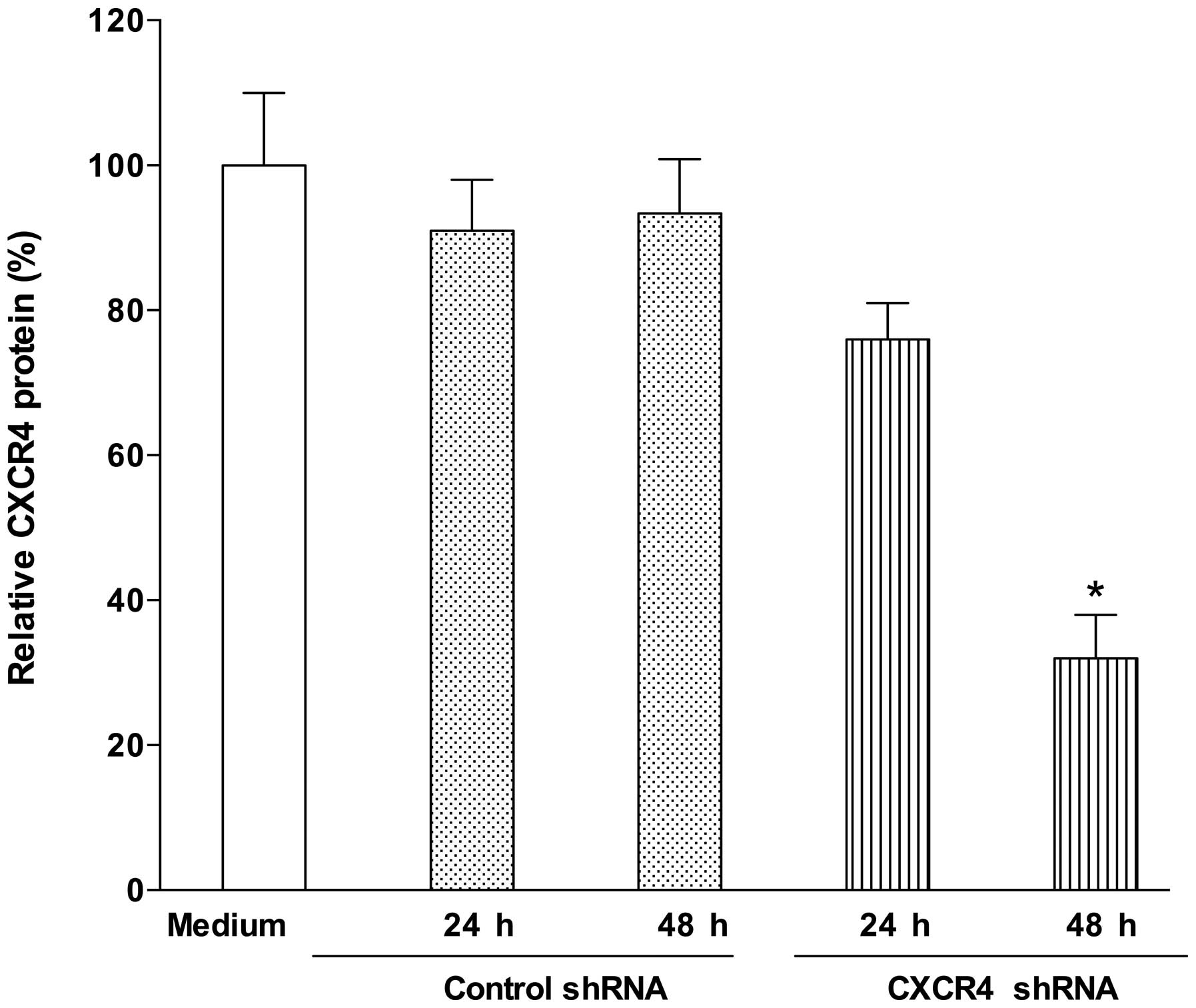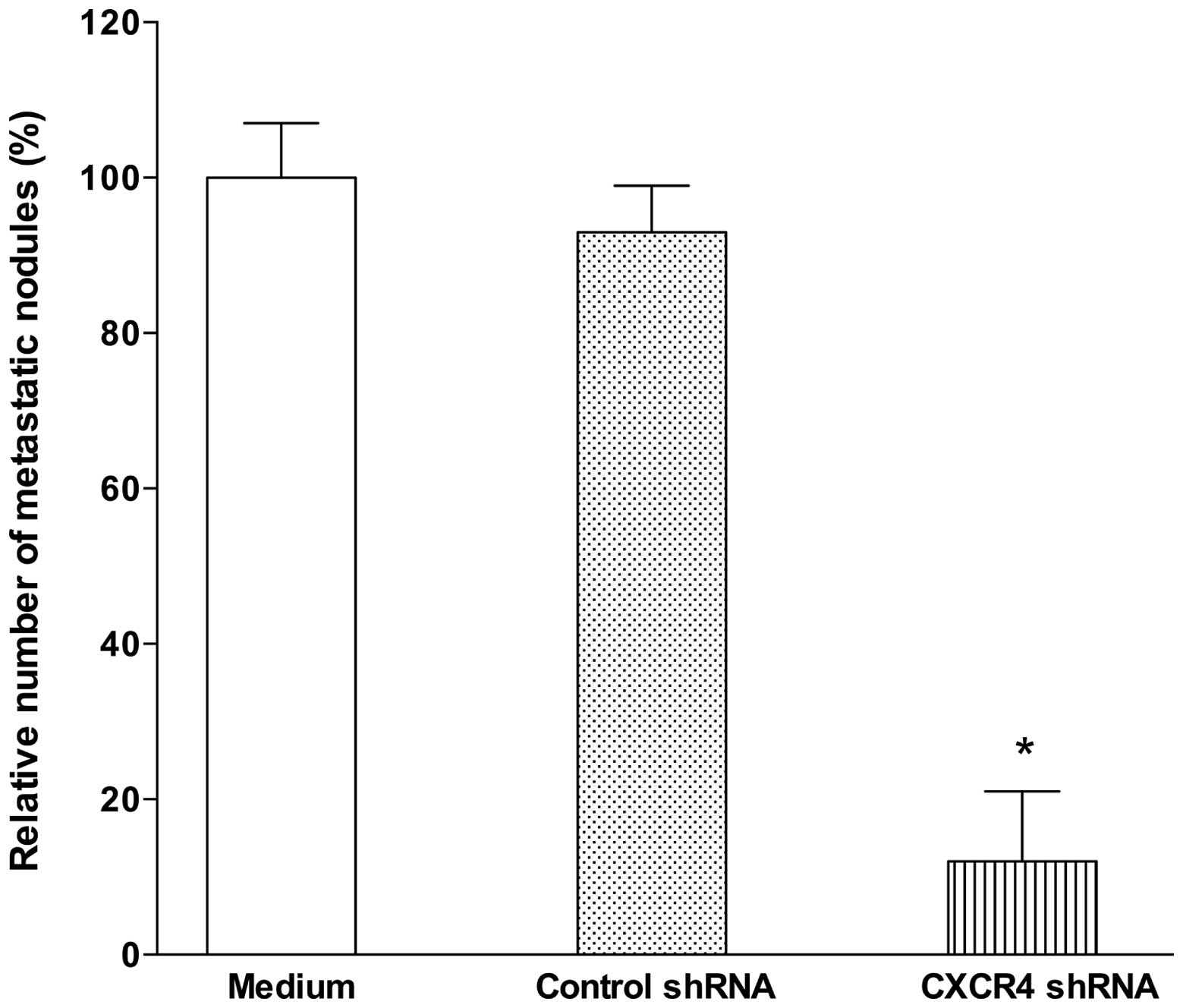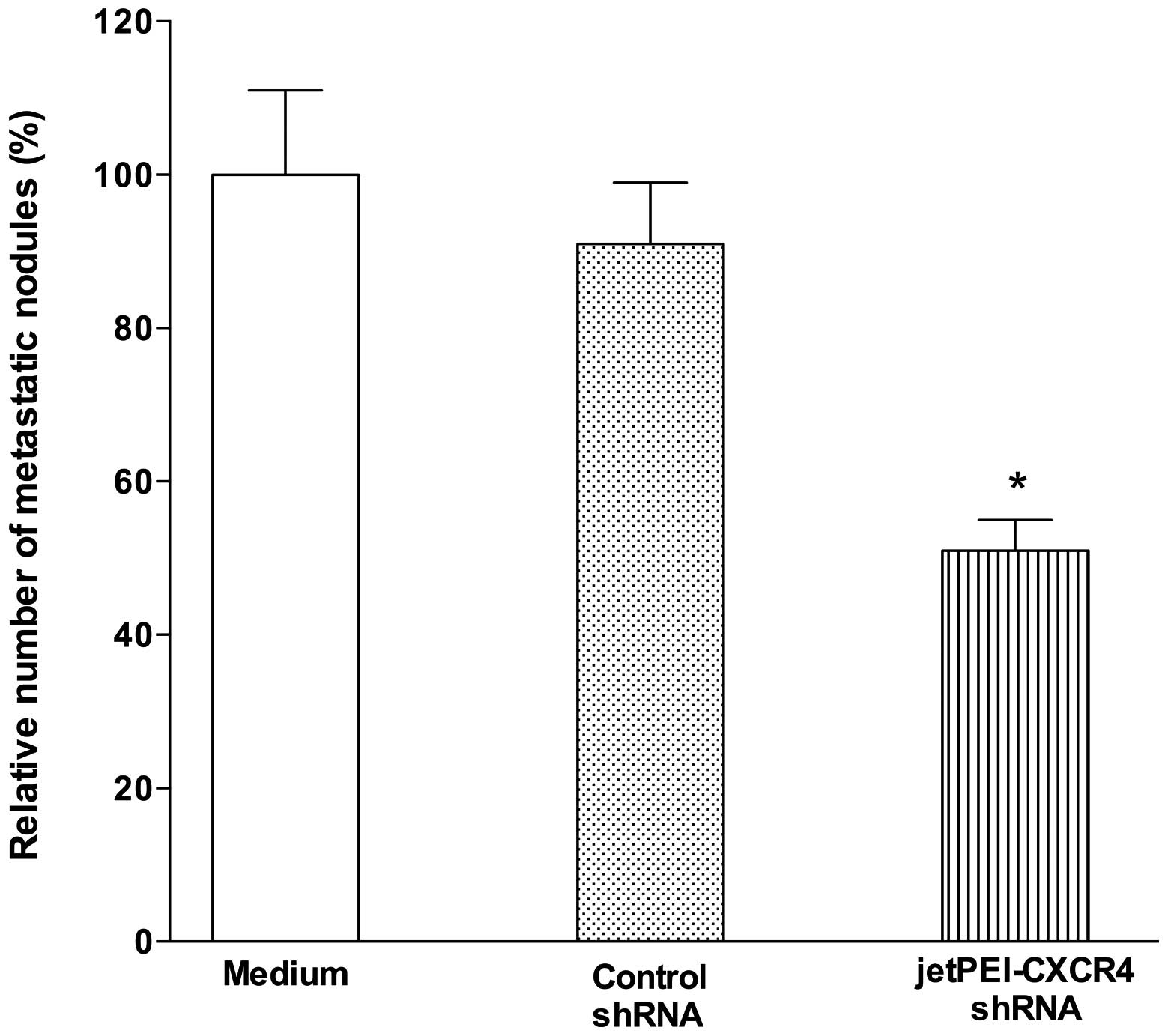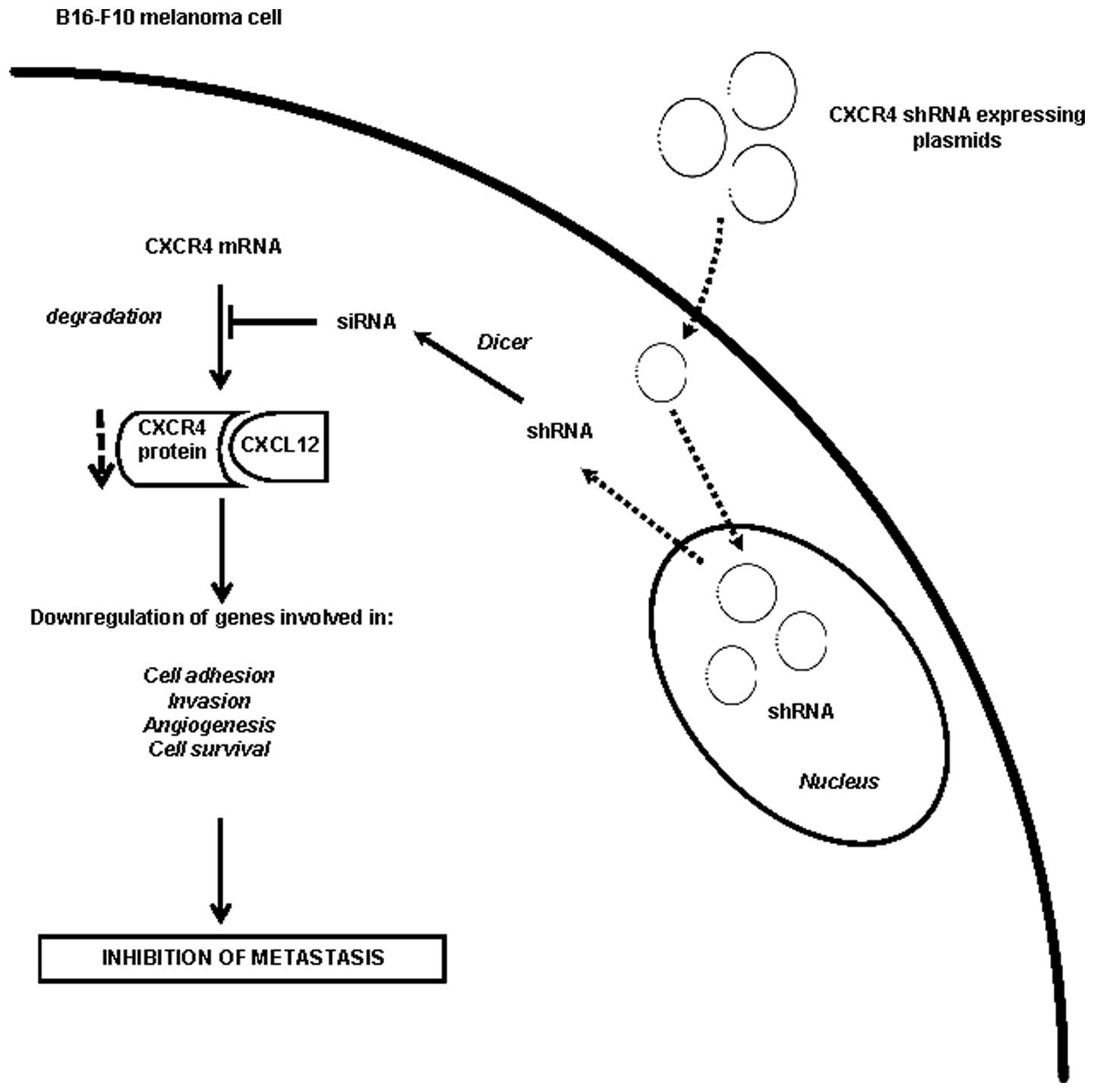|
1
|
Scala S, Giuliano P, Ascierto PA, Ieranò
C, Franco R, Napolitano M, Ottaiano A, Lombardi ML, Luongo M,
Simeone E, et al: Human melanoma metastases express functional
CXCR4. Clin Cancer Res. 12:2427–2433. 2006. View Article : Google Scholar : PubMed/NCBI
|
|
2
|
Tsao H, Atkins MB and Sober AJ: Management
of cutaneous melanoma. N Engl J Med. 351:998–1012. 2004. View Article : Google Scholar : PubMed/NCBI
|
|
3
|
Chatterjee S, Behnam Azad B and Nimmagadda
S: The intricate role of CXCR4 in cancer. Adv Cancer Res.
124:31–82. 2014. View Article : Google Scholar : PubMed/NCBI
|
|
4
|
Zlotnik A: Chemokines in neoplastic
progression. Semin Cancer Biol. 14:181–185. 2004. View Article : Google Scholar : PubMed/NCBI
|
|
5
|
Zlotnik A, Burkhardt AM and Homey B:
Homeostatic chemokine receptors and organ-specific metastasis. Nat
Rev Immunol. 11:597–606. 2011. View
Article : Google Scholar : PubMed/NCBI
|
|
6
|
Murdoch C: CXCR4: Chemokine receptor
extraordinaire. Immunol Rev. 177:175–184. 2000. View Article : Google Scholar
|
|
7
|
Müller A, Homey B, Soto H, Ge N, Catron D,
Buchanan ME, McClanahan T, Murphy E, Yuan W, Wagner SN, et al:
Involvement of chemokine receptors in breast cancer metastasis.
Nature. 410:50–56. 2001. View
Article : Google Scholar : PubMed/NCBI
|
|
8
|
Toyozawa S, Kaminaka C, Furukawa F,
Nakamura Y, Matsunaka H and Yamamoto Y: Chemokine receptor CXCR4 is
a novel marker for the progression of cutaneous malignant
melanomas. Acta Histochem Cytochem. 45:293–299. 2012. View Article : Google Scholar : PubMed/NCBI
|
|
9
|
Mitchell B, Leone D, Feller JK, Bondzie P,
Yang S, Park HY and Mahalingam M: Correlation of chemokine receptor
CXCR4 mRNA in primary cutaneous melanoma with established
histopathologic prognosticators and the BRAF status. Melanoma Res.
24:621–625. 2014. View Article : Google Scholar : PubMed/NCBI
|
|
10
|
Zhou J, Liu R, Wang Y, Tang J, Tang S,
Chen X, Xia K, Xiong W, Xu D, Wang S, et al: miR-199a-5p regulates
the expression of metastasis associated genes in B16-F10 melanoma
cells. Int J Clin Exp Pathol. 7:7182–7190. 2014.
|
|
11
|
Burger JA and Kipps TJ: CXCR4: A key
receptor in the crosstalk between tumor cells and their
microenvironment. Blood. 107:1761–1767. 2006. View Article : Google Scholar
|
|
12
|
Duda DG, Kozin SV, Kirkpatrick ND, Xu L,
Fukumura D and Jain RK: CXCL12 (SDF1-α) - CXCR4/CXCR7 pathway inhi
bition: An emerging sensitizer for anticancer therapies. Clin
Cancer Res. 17:2074–2080. 2011. View Article : Google Scholar : PubMed/NCBI
|
|
13
|
Li Z, Li N, Wu M, Li X, Luo Z and Wang X:
Expression of miR-126 suppresses migration and invasion of colon
cancer cells by targeting CXCR4. Mol Cell Biochem. 381:233–242.
2013. View Article : Google Scholar : PubMed/NCBI
|
|
14
|
Fidler IJ: Biological behavior of
malignant melanoma cells correlated to their survival in vivo.
Cancer Res. 35:218–224. 1975.PubMed/NCBI
|
|
15
|
Bobek V, Kolostova K, Pinterova D,
Kacprzak G, Adamiak J, Kolodziej J, Boubelik M, Kubecova M and
Hoffman RM: A clinically relevant, syngeneic model of spontaneous,
highly metastatic B16 mouse melanoma. Anticancer Res. 30:4799–4803.
2010.PubMed/NCBI
|
|
16
|
Chung TW, Choi HJ, Lee JY, Jeong HS, Kim
CH, Joo M, Choi JY, Han CW, Kim SY, Choi JS and Ha KT: Marine algal
fucoxanthin inhibits the metastatic potential of cancer cells.
Biochem Biophys Res Commun. 439:580–585. 2013. View Article : Google Scholar : PubMed/NCBI
|
|
17
|
Novina CD and Sharp PA: The RNAi
revolution. Nature. 430:161–164. 2004. View
Article : Google Scholar : PubMed/NCBI
|
|
18
|
Masiero M, Nardo G, Indraccolo S and
Favaro E: RNA interference: implications for cancer treatment. Mol
Aspects Med. 28:143–166. 2007. View Article : Google Scholar : PubMed/NCBI
|
|
19
|
Mansoori B, Sandoghchian Shotorbani S and
Baradaran B: RNA interference and its role in cancer therapy. Adv
Pharm Bull. 4:313–321. 2014.PubMed/NCBI
|
|
20
|
Delgado André N and De Lucca FL: Knockdown
of PKR expression by RNAi reduces pulmonary metastatic potential of
B16-F10 melanoma cells in mice: Possible role of NF-kappaB. Cancer
Lett. 258:118–125. 2007. View Article : Google Scholar : PubMed/NCBI
|
|
21
|
André ND, Silva VA, Watanabe MA and De
Lucca FL: Intratumoral injection of PKR shRNA expressing plasmid
inhibits B16-F10 melanoma growth. Oncol Rep. 32:2267–2273.
2014.PubMed/NCBI
|
|
22
|
Cadman E, Bostwick JR and Eichberg J:
Determination of protein by a modified Lowry procedure in the
presence of some commonly used detergents. Anal Biochem. 96(1):
21–23. 1979. View Article : Google Scholar : PubMed/NCBI
|
|
23
|
Yardeni T, Eckhaus M, Morris HD, Huizing M
and Hoogstraten-Miller S: Retro orbital injections in mice. Lab
Anim. 40:155–160. 2011. View Article : Google Scholar
|
|
24
|
Howard KA and Kjems J: Polycation-based
nanoparticle delivery for improved RNA interference therapeutics.
Expert Opin Biol Ther. 7:1811–1822. 2007. View Article : Google Scholar : PubMed/NCBI
|
|
25
|
Aigner A: Applications of RNA
interference: current state and prospects for siRNA-based
strategies in vivo. Appl Microbiol Biotechnol. 76:9–21. 2007.
View Article : Google Scholar : PubMed/NCBI
|
|
26
|
Gao S, Dagnaes-Hansen F, Nielsen EJ,
Wengel J, Besenbacher F, Howard KA and Kjems J: The effect of
chemical modification and nanoparticle formulation on stability and
biodistribution of siRNA in mice. Mol Ther. 17:1225–1233. 2009.
View Article : Google Scholar : PubMed/NCBI
|
|
27
|
Heesen M, Berman MA, Benson JD, Gerard C
and Dorf ME: Cloning of the mouse fusin gene, homologue to a human
HIV-1 co-factor. J Immunol. 157:5455–5460. 1996.PubMed/NCBI
|



